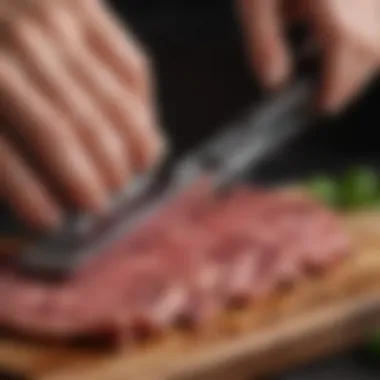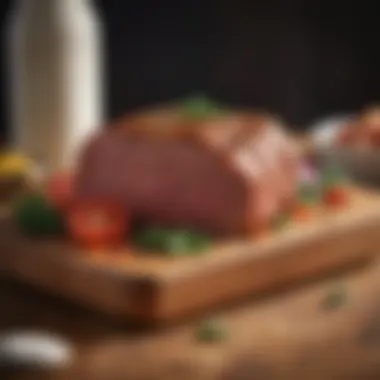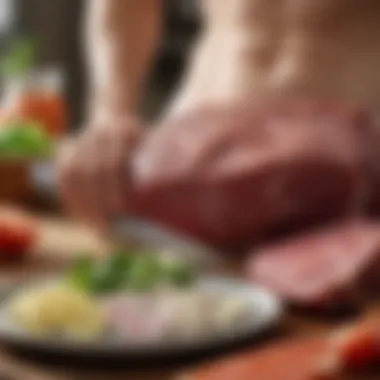Understanding Meat Fat Trimmers: A Comprehensive Guide


Intro
In the realm of culinary arts, meat fat trimmers often go unnoticed yet play a crucial role in meat preparation. These tools assist in eliminating excess fat from cuts of meat, helping to achieve a leaner, healthier dish. Understanding the mechanics and benefits of meat fat trimmers can significantly enhance one’s cooking experience and contribute to better health. This article explores various aspects of meat fat trimmers, addressing their functionality, types, and practical usage tips, providing a well-rounded perspective on this essential kitchen tool.
Recipe Overview
Recipe Name
Lean Grilled Steak
Description of the Dish
This dish showcases the delightful flavors of steak while minimizing fat content. The result is a tender, juicy bite that highlights the meat's natural taste without the heaviness of excess fat.
Importance of Fat Trimming
Fat trimming serves several purposes in meat preparation. Primarily, it reduces the amount of saturated fat in meals, contributing to healthier dietary consumption. Furthermore, trimming excess fat can lead to better cooking results, as fat can vastly influence both texture and flavor. On a practical level, using a meat fat trimmer allows for efficient and uniform fat removal, resulting in meat that cooks evenly.
Types of Meat Fat Trimmers
When it comes to selecting a fat trimmer, there are various styles available:
- Boning Knife: A versatile tool that allows for precise trimming around bones.
- Folding Knives: Compact and ideal for portability, suitable for quick trimming tasks on the go.
- Specialized Fat Trimmers: Designed specifically for fat removal, these tools often include features for added functionality.
Nutritional Implications
Trimming fat has notable nutritional advantages. Less fat means reduced calories and a healthier meal overall. However, consumers must also be aware that some fat is essential for flavor and satiety. Balancing fat content can lead to nutritious yet flavorful meals without compromise.
"The kitchen is where the health of your food begins. Proper tools can define flavors and improve well-being."
Practical Tips for Using Meat Fat Trimmers
To ensure effective meat trimming, consider the following tips:
- Always use a sharp knife for clean cuts.
- Trim fat slowly, taking your time to evaluate each cut.
- Practice makes perfect; start with less valuable cuts of meat.
- Regularly sharpen your tools to maintain efficiency.
Addressing Common Misconceptions
A common misconception is that all fat must be removed for a meal to be healthy. In reality, a certain amount of fat can be beneficial, contributing flavor and a satisfying mouthfeel. Understanding this concept is crucial for effective meat preparation and health-conscious cooking.
Selecting the Right Trimmer
Choosing the right meat fat trimmer depends on various factors. Analyze your cooking habits and evaluate the type of meat you often prepare. For instance, if working with larger cuts, a boning knife may be more suited than a folding knife. Ensure that the trimmer you choose feels comfortable in your hand; this enhances precision and efficiency.
The End
Understanding meat fat trimmers elevates one’s cooking skills. Knowledge about these tools enriches culinary practices, enabling home cooks to create healthier and more enjoyable meals. With the right tools and techniques, one can make informed choices that positively impact both cooking quality and nutritional intake.
Intro to Meat Fat Trimmers
The process of trimming meat has gained much attention in culinary practices, not only for aesthetic purposes but also for health considerations. Meat fat trimmers are essential tools that help individuals manage fat content in meat to improve both the flavor and nutritional value of dishes. This section will delve into the definition and purpose of these tools, as well as their historical context to provide a well-rounded understanding of their significance.
Definition and Purpose
A meat fat trimmer is a specialized tool designed specifically for the removal of excess fat from meat cuts. Unlike a standard kitchen knife, these trimmers often feature a blade that allows for precision cutting, which is fundamental for getting the maximum flavor while reducing unwanted fat. The primary purpose is to make meat healthier to eat without compromising the taste. By using a trimmer, cooks can enjoy meat dishes that retain the essence of flavor while adhering to dietary considerations. This is particularly important for people looking to lower their intake of saturated fats.
Historical Context
The art of trimming meat has roots that trace back to ancient practices, where butchers relied on rudimentary tools to prepare meat for consumption. Historically, fat was often viewed as a necessary aspect of meat, providing flavor and lubrication during cooking. However, as public awareness of health issues has evolved, attitudes towards fat have shifted considerably. The emergence of meat fat trimmers in modern kitchens reflects a growing preference for healthier cooking methods and the desire for food that aligns with contemporary nutritional standards. Over time, these tools have developed, and today’s designs are informed by both culinary needs and health consciousness, making them an invaluable part of the modern kitchen arsenal.


Key Insight: The evolution of meat fat trimmers illustrates a broader shift towards healthier eating habits, showcasing the balance between culinary tradition and modern nutritional practices.
Types of Meat Fat Trimmers
Understanding the various types of meat fat trimmers is essential for anyone looking to enhance their meat preparation practices. These tools come in two primary categories: manual and electric. Each type has distinct features and benefits that cater to different needs and preferences. Knowing the differences can significantly impact the quality of meat preparation, ultimately leading to healthier and more enjoyable meals.
Manual Trimmers
Manual trimmers are traditional tools made for precision and control. Their design and method of use vary, but generally, they require more physical effort and skill compared to their electric counterparts.
Knife Design
The knife design of manual trimmers is crucial in determining their effectiveness. Blade sharpness and geometry greatly influence how well a trimmer can cut through fat and tough meat surfaces. A common characteristic of effective knife design is a curved blade, which facilitates smooth and precise cuts. This feature is particularly beneficial in navigating the contours of different meat cuts, allowing for efficient fat removal without compromising the meat underneath.
While manual trimmers can provide superior control, they may require practice to master. A novice user might struggle to achieve the desired results. However, for skilled users, the versatility of manual trimmers can be advantageous, particularly when tackling a variety of meat textures.
Cutting Techniques
Cutting techniques employed with manual trimmers play a significant role in the fat trimming process. Steady hands and a well-practiced technique can be essential for achieving consistent results. Popular methods include using gentle, flowing motions to guide the knife against the fat, ensuring minimal loss of meat.
The benefit of mastering these techniques is that they can adapt to any cut of meat. A downside is that they often require the user to invest considerable time in practice to gain the necessary skill. Good cutting technique reduces wastelines and maximizes the quality of the meat retained after trimming.
Electric Trimmers
Electric trimmers represent a more modern approach to fat trimming, offering speed and efficiency. They are ideal for those who trim meats regularly or in larger quantities, providing a different user experience than manual models.
Functionality
Electric trimmers operate with the push of a button. They are typically equipped with sharp, rotating blades that can handle thick layers of fat quickly. This automated functionality allows for uniform cuts and reduces the physical effort required from the user. A significant characteristic is their ability to reduce user fatigue, especially when dealing with larger cuts or multiple pieces of meat.
Despite their advantages, electric models may lack the control that a skilled user enjoys with manual trimmers. Additionally, they can be more cumbersome to clean and maintain.
Advantages over Manual Models
Electric trimmers provide several advantages over manual ones. Speed is a primary benefit; they save time and labor when trimming larger amounts of meat. Moreover, many electric trimmers come with adjustable settings, allowing users to customize blade speed and cutting depth according to their needs. This flexibility enhances the trimming experience, making the process more straightforward.
On the flip side, electric trimmers can be expensive and may not be practical for casual cooks. They also depend on electricity, which can be a consideration in certain cooking environments.
In summary, each type of meat fat trimmer brings its own strengths and challenges. Understanding the differences can help cooks choose the appropriate tool for their specific meat preparation tasks.
Benefits of Using Meat Fat Trimmers
Using meat fat trimmers can greatly enhance both health and culinary enjoyment. Understanding these benefits is crucial for anyone involved in preparing meat, whether professionally or at home. The right use of these tools can lead to healthier meal options and improved cooking experiences. Below, we explore specific health considerations as well as enhancements in culinary experiences provided by meat fat trimmers.
Health Considerations
Reduction of Saturated Fat
Reducing saturated fat is a main health benefit of using meat fat trimmers. Fatty cuts of meat can contribute significant amounts of saturated fat, which is linked to health issues like heart disease. By effectively trimming fat, individuals can directly lower the intake of these unhealthy fats. This action helps to promote a balanced diet. Many appreciate this aspect of fat trimming since it aligns with health-conscious choices. Moreover, as more people pursue healthier lifestyles, the reduction of saturated fat stands out as a prominent reason to utilize meat fat trimmers.
Improved Nutritional Profile
Another critical aspect of using meat fat trimmers is achieving an improved nutritional profile. When excess fat is trimmed away, the overall quality of the meat becomes better. It becomes leaner and thus contains fewer calories. This change can cater to specific dietary needs, individuals looking to maintain a healthy weight can benefit greatly. A leaner meat choice provides a concentrated source of protein while reducing unnecessary calories. Trimming excess fat contributes positively to meal planning and nutrition. It reflects a thoughtful approach to cooking that resonates with many food enthusiasts today.
Enhanced Culinary Experience
Improving Flavor
Flavor enhancement is a notable advantage when using meat fat trimmers. While fat can contribute flavor, excessive fat can overshadow the true taste of the meat. By removing excess fat, the natural flavors of high-quality meats can shine through. Additionally, many cooking methods, such as grilling or roasting, benefit from a cleaner cut of meat. This way, the flavors develop correctly and are much more enjoyable. Culinary professionals and home cooks alike find that optimal flavor is essential in creating satisfying meals.


Textural Consistency
Lastly, textural consistency is an important factor in meat preparation. Trimming fat properly ensures uniformity in cooking. Different textures can impact how enjoyable a dish is. When meats are trimmed effectively, the results tend to be more consistent for different cooking methods. This aspect is crucial for presenting dishes that meet high culinary standards. With improved texture, the overall eating experience is enhanced, allowing one to appreciate the quality and craftsmanship in the preparation.
Effective trimming techniques can contribute significantly to your health and culinary satisfaction.
In summary, the use of meat fat trimmers results in healthier dishes and richer culinary experiences. The continued knowledge and application of trimming are essential for food enthusiasts dedicated to quality cooking.
Choosing the Right Meat Fat Trimmer
Selecting the appropriate meat fat trimmer is essential for both novice cooks and seasoned chefs. The right trimmer can significantly impact the quality of meat preparation, offering measurable benefits regarding health and taste. With varying types and functionalities available, making an educated decision requires understanding individual needs and considering key features that enhance the trimming experience.
Assessing Personal Needs
Frequency of Use
When determining the ideal meat fat trimmer, one must first consider how often the tool will be used. Understanding your frequency of use helps narrow down options that fit your lifestyle. A trimmer suited for frequent use should be durable and efficient. For example, professional chefs or those hosting regular gatherings might require a robust electric trimmer. On the other hand, casual cooks may find that a manual option suffices.
Repeated use also leads to familiarity with the tool, improving one's proficiency in fat trimming. However, frequent use of a low-quality trimmer could lead to frustration and waste of time. Therefore, a balance between durability and usability is crucial.
Types of Meat
The types of meat you typically work with are another critical factor. Different meats have varying fat content and textures, necessitating specific trimming tools. For instance, trimming beef may require a sturdier blade compared to delicate poultry. Knowing the primary types of meat you handle can directly influence your choice of trimmer.
Moreover, some trimmers may be better suited for certain meats than others, affecting overall performance. For someone who frequently works with pork or lamb, selecting a versatile trimmer that performs well across a range of meats can enhance efficiency in the kitchen.
Key Features to Consider
Blade Material
One of the most significant aspects to evaluate is blade material. High-quality blades can determine the effectiveness of the trimming process. Stainless steel is a popular choice because of its resistance to rust and corrosion, making it ideal for food preparation. The sharpness and edge retention properties are crucial as well. A sharper blade reduces the effort required during cutting and helps achieve cleaner cuts.
A downside to some materials, like carbon steel, is that they can be less resistant to moisture, requiring more maintenance. For the average cook, a stainless steel option is generally recommended due to its combination of sharpness and low maintenance needs.
Handle Comfort
The handle comfort cannot be overlooked when choosing a meat fat trimmer. An ergonomically designed handle allows for extended use without discomfort or strain on the hand. This feature is especially important for those who engage in regular meat preparation or batch cooking. Comfort helps maintain grip and control, significantly affecting the quality of cuts.
Additionally, some handles come with rubberized grips to prevent slipping, which increases safety during the trimming process. While a comfortable handle may not seem essential, it plays a critical role in preventing fatigue and ensuring precision.
In summary, choosing the right meat fat trimmer requires careful consideration of personal needs, including frequency of use and types of meat. By focusing on key features like blade material and handle comfort, one can make an informed decision that elevates the overall cooking experience.
Techniques for Effective Fat Trimming
Techniques for effective fat trimming are fundamental in achieving optimal culinary results. Proper methods not only enhance the look of the meat but can also improve its taste and texture. When fat is trimmed correctly, it allows the natural flavors of the meat to shine, while also promoting healthier eating habits.
Preparation of Meat
Selecting Quality Cuts
Selecting quality cuts of meat plays a crucial role in the fat trimming process. High-quality cuts generally have a better fat distribution, making them easier to trim and more appealing when cooked. Key characteristics of good cuts include marbling and thickness. These traits are advantageous, as they ensure the flavor is retained even after trimming excess fat.
One unique feature of selecting premium cuts is that they may contain flavor-packed fat known as intramuscular fat. This fat melts during cooking, enriching the dish without compromising health. The disadvantage may be higher costs compared to lower quality meat. Nonetheless, investing in quality cuts is beneficial for those who appreciate culinary excellence.
Chilling for Easier Trimming
Chilling for easier trimming is another important technique. Cooling meat makes the fat firm up, facilitating cleaner and more precise cuts. The key characteristic is that chilled meat is less slippery, making it easier to grip and manipulate. This technique is popular among chefs and home cooks alike for its effectiveness.
A unique feature of this approach is that it reduces the chances of tearing the meat during trimming. One disadvantage may be the time required for the chilling process, but the results often justify the wait, leading to neater, more controlled trimming.


Step-by-Step Trimming Process
Identifying Fat Types
Identifying fat types is paramount in the trimming process, as different fats have various textures and flavors. Recognizing the distinction between subcutaneous fat and intermuscular fat can guide your trimming decisions. Subcutaneous fat is located just under the skin and is typically thicker. On the other hand, intermuscular fat, or marbling, is embedded within the muscle fibers.
The key characteristic of identifying fat types is that it allows for more targeted trimming. By knowing what to keep and what to remove, cooks can maximize flavor while minimizing excess fat. One unique feature of this skill is that it enhances the understanding of the meat’s overall structure, which contributes to better cooking results. However, the learning curve can be steep for beginners.
Best Practices for Removal
Best practices for removal involve techniques that ensure efficient fat trimming while preserving the meat’s quality. Employing a sharp knife and making smooth motions can help to achieve cleaner cuts. The key characteristic of this approach is that it minimizes waste, allowing for greater portions of usable meat.
A unique feature of these best practices is the ability to create visually appealing cuts, enhancing the presentation of dishes. While the process may take practice, it is undoubtedly a beneficial skill for anyone serious about cooking quality meat. Improper techniques, however, can lead to issues such as uneven cuts, which might compromise the final dish.
Common Misconceptions about Meat Fat Trimmers
Understanding meat fat trimmers involves addressing some common misconceptions that can lead to misinformed decisions by consumers. These misunderstandings can affect how people perceive the utility of such tools in their culinary practices. It is crucial to explore these misconceptions regarding trimming and the inherent nature of fat in meat to foster a better comprehension of how proper usage can benefit both health and cooking.
Trimming Equals Waste
One prevalent myth is that trimming fat from meat is an act of waste. This view stems from the traditional mindset that any removal of meat equates to losing potential food value. However, this oversimplified thought does not take into account several factors. Trimming excess fat can significantly enhance culinary experiences. By meticulously removing undesirable fat, one can improve the overall flavor and texture of the dish. Moreover, fat does not always contribute positively to taste; sometimes it can lead to greasiness or an unappealing mouthfeel.
It is important to emphasize that the trimming process should be focused on it being more of a refining tool. When utilized effectively, it allows for the best cuts of meat to shine through. Additionally, carefully removed fat can be used creatively in other dishes or applications, such as rendering for cooking oil, making sauces, or even as flavor additions to stocks.
This shows the necessity of understanding trimming as a means to enhance, rather than waste.
Fat is Always Unhealthy
Another common misconception is that all fat in meat is unhealthy. The distinction between different types of fat is often overlooked. For instance, fat serves several crucial functions in cooking, including moisture retention and flavor enhancement. It is essential to differentiate between saturated and unsaturated fats, as well as contextualize their impact based on eating habits.
Too simplify, not all fat is created equal. For instance, while high amounts of saturated fats may pose health risks, moderate consumption of unsaturated fats can contribute positively to a balanced diet. Additionally, when trimming fat, the goal should be balance rather than elimination. Maintaining a perspective that considers the nutritional context of a meal enables more informed decisions about meat preparation.
Sustainability Considerations
Sustainability in food preparation is an increasingly important topic that resonates with both consumers and culinary professionals alike. As awareness grows about the environmental impact of food production, the role of tools like meat fat trimmers becomes more significant. These trimmers not only contribute to a healthier lifestyle but also align with sustainable practices that minimize waste and promote responsible sourcing.
Waste Reduction through Trimming
One of the primary sustainability advantages of meat fat trimmers is their capacity to reduce food waste. The trimming process allows cooks to separate unwanted fat, which can lead to healthier meals. The remaining meat is often of higher quality, promoting better consumption habits. When fat is trimmed effectively, less meat goes into the trash, and the overall utilization of the animal is maximized.
By using trimmers to cut fat, households can also create a more efficient cooking experience. For instance, the fat trimmed can be rendered into lard or tallow, providing additional culinary uses rather than being discarded. This ensures that every part of the meat is utilized, respecting the animal and making the most of the resources.
"Reducing waste is not just a goal; it's an essential part of responsible cooking."
Ethical Meat Sourcing
In considering sustainability, ethical sourcing of meat also comes into play. Utilizing a meat fat trimmer aligns with the philosophy of choosing quality over quantity. By selecting suppliers who prioritize humane treatment of animals and environmentally friendly practices, cooks invest not only in their health but in the wellbeing of ecosystems and communities.
When a meat fat trimmer is employed, attention to cuts can encourage the selection of meats from sustainable sources. This involves paying close attention to indications of ethical farming, such as grass-fed options or local suppliers who adhere to humane practices. Supporting these sources emphasizes a holistic approach to meat consumption, as it incorporates health, wellness, and sustainability into daily cooking routines.
Thus, in a broader context, the responsible use of meat fat trimmers reflects a commitment to better cooking practices while considering the long-term impacts of food choices on the environment and animal welfare. Advocating for sustainability in this manner can inspire others to reflect on their own practices, potentially leading to a collective shift towards more responsible consumption.
Epilogue
The topic of meat fat trimming is critical in understanding culinary practices and enhancing meal quality. This article underscores the significance of meat fat trimmers in cooking. These tools not only aid in achieving a leaner meat preparation but also play a vital role in health-conscious cooking. Trimming fat can lead to substantial health benefits such as decreased saturated fat intake and improved overall nutrition.
Moreover, the process of using meat fat trimmers can enhance culinary experiences. Fat removal can improve flavor and create a better texture, allowing for more enjoyable meals. The trimming process, when done correctly, enhances both aesthetic and gastronomic aspects of meat dishes.
"Trimming the right amount of fat contributes positively to dishes, keeping flavors balanced while supporting healthier choices."
Additionally, we discussed common misconceptions associated with meat fat. It is important to recognize that fat is not inherently bad. The strategic trimming of fat can lead to a more mindful approach to dining, promoting understanding of food sources and nutritional values.
The selection of the right trimmer is also paramount. Consumers should take into account their needs, frequency of use, and the specific types of meat they prepare. The insights provided throughout this article help facilitate informed decisions for both beginners and seasoned cooks in the kitchen.
In summary, understanding meat fat trimmers and their effective use fosters not only cooking skills but also cultivates a deeper appreciation for food. As culinary practices continue to evolve, adopting this knowledge can transform how individuals engage with their meals.







